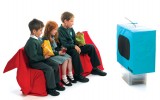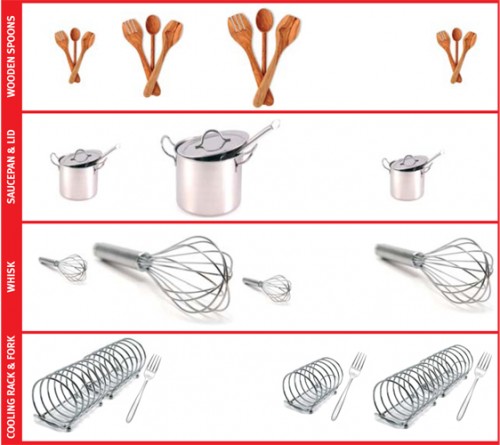Sue Nicholls whets the appetite with two hearty songs and a generous serving of cross curricular activities...
Our obsession with the gastronomic world has been immortalised in many a song. Perhaps one of the best known examples is Lionel Bart’s Food, glorious food from the musical Oliver. Boiled beef and carrots! and If I knew you were comin’ I’d've baked a cake also come to mind, but there’s a feast of other musical morsels just waiting to be devoured.
If you’re pursuing Healthy Schools status, then singing about food is a good way to promote pupils’ knowledge of what constitutes a balanced diet. Lively lyrics can steer children away from salt and sugar-heavy snacks through a greater understanding of the benefits of balanced nutrition. Songs can also be a springboard to investigating other areas of the curriculum, as demonstrated by these two delectable ditties.
This simple and accessible song for KS1, sung to tune of Hickory Dickory Dock, has a strong message about the virtues of eating vegetables. It was first published in Food from the series Themes for Early Years by Scholastic and reproduced here by kind permission of the publishers.
Never say ‘No’ to your greens! [clap, clap]
Like cabbage or spinach or beans! [clap, clap]
So crisp and new and good for you,
Never say ‘No’ to your greens! [clap, clap]
Make a list of vegetable names. Pick two and substitute these for the words ‘cabbage’ and ‘spinach’ in the second line of the song, e.g. ‘Like lettuce and turnips…’. Make sure you keep the word ‘beans’ to maintain the rhyme with ‘greens’. Don’t just stick to common veggies either, conduct research and include some really exotic varieties: cassava, yuca, chard and tamarillo, for example.
1. Design technology
Design some ‘fruit’n'veg’ shakers to play on the clapped beats. Experiment with a range of different pulses or dried pasta shapes to create varied sounds, but never dried beans – these can be dangerous if accidently eaten raw! Why not substitute dried fruit pieces such as banana chips or dried mango and develop listening and investigative skills by ordering your class shakers from quietest to loudest.
2. Music theatre
Perform the song in a ‘Healthy Food’ assembly, incorporating additional verses with new veggie names. Divide the lyrics between different groups of singers, invent some engaging actions, accompany with shakers and encourage the audience to join in with the final line: ‘Never say ‘No’ to your greens!’
 This amusing ditty – sung to the tune of Knees up, Mother Brown! – warns of the dangers of bad eating habits and a lack of exercise. The song is one of the activities found in the Singing Breakfast Club packs produced by ContinYou. For more information on ContinYou and the opportunity to download free Singing Breakfast Club resources, please visit continyou.org.uk
This amusing ditty – sung to the tune of Knees up, Mother Brown! – warns of the dangers of bad eating habits and a lack of exercise. The song is one of the activities found in the Singing Breakfast Club packs produced by ContinYou. For more information on ContinYou and the opportunity to download free Singing Breakfast Club resources, please visit continyou.org.uk
Verse 1
Sat on our settee, sat on our settee,
Watching telly, watching telly,
Sat on our settee!
For other verses – substitute ‘Sat on our settee’ with the following:
Verse 2 – Munching bags of crisps…
Verse 3 – Scoffing apple pie…
Verse 4 – Greasy bags of chips…
Verse 5 – Pizza slices next…
Verse 6 – Doughnuts for our pud…
Verse 7 – Feeling really ill…
Verse 8
Stuck on our settee, stuck on our settee Feeling worse, I’m going to burst! Stuck on our settee!
Spoken: And the moral of our story is:
Final verse
Switch off that TV! Have a proper tea! Eat more salad! Sing this ballad! Don’t end up like me!
1. Music
Compose accompaniments using packaging, particularly focusing on the containers of foods named in the song: greaseproof paper, crisp packets, pizza boxes and foil pie cases. Why not organise a ‘band’ to play a musical introduction on these unconventional sound sources as the actors walk on stage?
2. Drama
Rehearse a performance of the song Don’t be a couch potato! for an assembly. Creating a set is easy; just push several chairs together and drape a blanket over the top to make a large ‘settee’. Construct an over-sized TV from cardboard.
As each new verse is sung, send on an actor carrying a model or picture of the appropriate food. Assign roles to singers (both on the settee and extras on stage), the speaker (who reads the moral) and the extra walk-on parts for each verse. Get the message across by singing in theatrically blobby voices supported by exaggerated couch potato poses – that is until the final verse, which should be really energised and upbeat.
3. Song-writing
Use another familiar tune to inspire pupils to write their own lyrics and create a healthy partner song The Exercise Encourager, using the tune of One finger, one thumb keep moving. The structure of the tune requires no rhyming word patterns, because the first three lines are always the same, providing a simple but effective scaffold for song-writing:
Try galloping round the playground
Try galloping round the playground
Try galloping round the playground
.... And keep in better shape!
I hope the ideas in this article have inspired you. By harnessing the impact of Healthy Schools through music-making and song, you can plan a feast of cross-curricular ideas to support teaching and learning in your setting. Bon appétit!
Create a classical cacophony to the music of Vaughan Williams…
Listen to March past of the kitchen utensils composed by Ralph Vaughan Williams. It’s a quirky piece of music in which there are loud and unexpected musical ‘crashes’, just as if the pots and cutlery are banging into each other.
Now organise a collection of kitchen utensils that make really interesting sounds (e.g. a saucepan tapped with a spatula, or clay baking beans shaken in a beaker) and encourage children to experiment with different combinations to find the best sound effects. Listen to the piece several times and count to work out exactly when the loud beats occur. Then armed with kitchen ‘instruments’, get all the children joining in by playing on the sudden bursts of sounds.

Look at the graphic score above with its symbols for each of the kitchen implements. Explain to the class that each line of the score is played by a performer who improvises sounds on his or her saucepan and lid, wooden spoons, whisk, or cooling tray and fork as indicated by the symbol. The symbols are to be interpreted as each player deems appropriate. For instance, a small wooden spoon symbol may suggest a quiet sound whereas a large spoon may invite a louder one.
The score is played from left to right and conducted with a long pointer held vertically across all four lines. Remember that empty spaces are silences or ‘rests’. Invite groups of children to play through the score until everyone has had a turn and then talk together about how the symbols were interpreted and which players’ ideas worked best musically. Encourage groups of children to investigate the sounds they want to include in their composition and then create their own symbols for a score.
Why every child should feel at home in an art gallery
Ace-Art-And-Design
Pie Corbett’s bike poems
Topic
